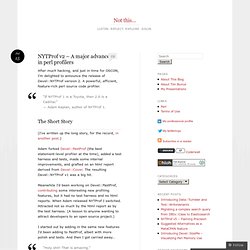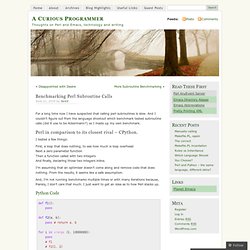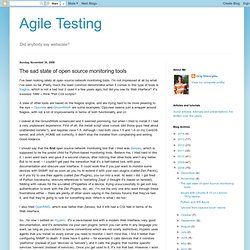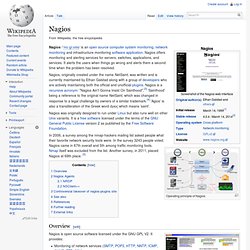

Bong. NYTProf v2 - A major advance in perl profilers « Not this… After much hacking, and just in time for OSCON, I’m delighted to announce the release of Devel::NYTProf version 2.

A powerful, efficient, feature-rich perl source code profiler. “If NYTProf 1 is a Toyota, then 2.0 is a Cadillac” — Adam Kaplan, author of NYTProf 1. (I’ve written up the long story, for the record, in another post.) Adam forked Devel::FastProf (the best statement-level profiler at the time), added a test harness and tests, made some internal improvements, and grafted on an html report derived from Devel::Cover. The resulting Devel::NYTProf v1 was a big hit. Meanwhile I’d been working on Devel::FastProf, contributing some interesting new profiling features, but it had no test harness and no html reports. A Curious Programmer. Benchmarking Perl Subroutine Calls June 21, 2010 by Jared For a long time now I have suspected that calling perl subroutines is slow.

And I couldn’t figure out from the language shootout which benchmark tested subroutine calls (did it use to be Ackermann?) So I made up my own benchmark. Perl in comparison to its closest rival – CPython. Munin - Trac. Monit. The sad state of open source monitoring tools. I've been looking lately at open source network monitoring tools.

I'm not impressed at all by what I've seen so far. Pretty much the least common denominator when it comes to this type of tools is Nagios, which is not a bad tool (I used it a few years ago), but did you see its Web interface? It's soooooo 1999 -- think 'Perl CGI scripts'! A slew of other tools are based on the Nagios engine, and are trying hard to be more pleasing to the eye -- Opsview and GroundWork are some examples. Index of /~ben/funkload. Daily Artisan » 12 Tools To Decrease Website Load Times. Patience is not the average web user’s strongest point.

There is little to gain in being the first selected from a search result page if your site takes an agonizingly long time to load, resulting in the user clicking away. Excessive load time does not create a user-friendly experience and encourage regular use. Methods such as load balancing, compression and caching can aid in efficient operation and taking steps to optimize your site are both beneficial and, in most cases, free.
Here is a list of 12 tools that can help you decrease your website’s load times. 1. YSlow is a Firefox extension which makes use of the popular web development tool, Firebug, to analyze and inform you why a particular page is slow based on guidelines for high performance sites and provides you with: 1. 2. 3. 4. 5. 24 Great Open Source Apps for Admins & Technicians - Download Squad. I'm always on the lookout for apps that can ease my workload or free up some room in my budget, and open source applications are an excellent way for me to accomplish both.

If you're in the same boat as me, hopefully you're already utilizing some open source options. If not, I've put together this list of two dozen great applications that I can depend on to keep things running smoothly on my office LAN and customer systems as well. Some of these you'll recognize, but I hope that there are some that are new to you as well. PING - I may be beating a dead horse here with my love of PING, but it's just a great piece of open source. Drive imaging with network and spanning support, password blanking, it's just an excellent app. Nagios. Operating principle of Nagios Nagios /ˈnɑːɡiːoʊs/ is an open source computer system monitoring, network monitoring and infrastructure monitoring software application.

Nagios offers monitoring and alerting services for servers, switches, applications, and services. It alerts the users when things go wrong and alerts them a second time when the problem has been resolved. Nagios was originally designed to run under Linux but also runs well on other Unix variants. It is a free software licensed under the terms of the GNU General Public License version 2 as published by the Free Software Foundation. In 2006, a survey among the nmap-hackers mailing list asked people what their favorite network security tools were. Server Oriented System Tuning Info. More Persistent Vectors: Performance Analysis. 1 Sep 2008 In my previous post, I introduced the concept of "persistent vectors" and walked through one implementation of the idea.

When I actually pushed the post out, I was pretty happy with my code, but it seems I still have much to learn. A number of very smart people replied, suggesting ways that the implementation could be cleaned up and improved. Among these intrepid commenters was David MacIver, who correctly pointed out the similarities between my persistent vector and his IntMap class (coming in Scala 2.7.2). Needless to say, my interest was piqued, so over the course of last week, I spent a fair amount of time going over his implementation as well as the implementations proposed by researchers in the past.